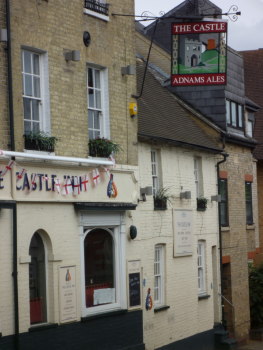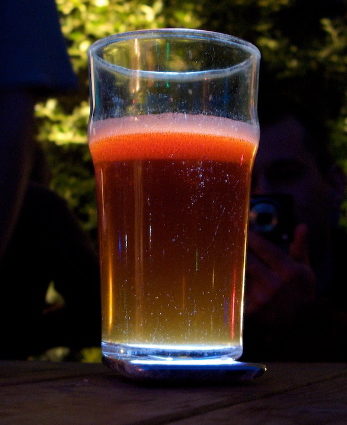
The Lager Lamp was born in this pub in Cambridge, England, sometime in the early Naughties. Someone had returned from the bar with a huge tray of very similar-looking beers that were actually of several different sorts. The problem was easily solved with the use of a caver's lamp that someone conveniently had with them: plonk the beer on the lamp and you can see its inner colour - and its inner beauty.
Yes, not only is a Lager Lamp a practical tool for beer identification, but it is also a way to get even more joy from your beer. (But watch out: if you spend too long looking at your glowing pint you might forget to drink it.)
The very first real Lager Lamps were made of wood. These sturdy gadgets did a good job but manufacturing was time-consuming. This early success was followed by a couple of wrong turns: a mains powered version was made but soon rejected on safety grounds - not for the combination of high voltages and liquids, but because it was bright enough to blind.
The Lager Lamp With Knobs On (red, green and blue individually controllable) was another non-starter: only one was ever made, and it was simply too expensive ever to reach the market.
Finally, perfection was found in the form of laser-cut acrylic. Sadly the actual laser-cutting had to be subcontracted: again, health and safety rules stopped me from installing a massive laser in my shed. About three of these precious items have made it out into the world - so far.

But why use a physical Lager Lamp when you carry a chameleon, a multi-purpose gadget that can fulfil any role, with you all the time? Yes, the Lager Lamp went virtual: the Lager Lamp iPhone App. Compared to the physical lamps, the app was cheaper, easier to obtain, and more versatile: you could adjust the size to match your glass and tweak the colour to bring out the best in your beer.
Furthermore, if you wanted to draw more attention to yourself (for example, if you weren't the only one with a glowing pint of Chernobyl-juice in the pub), then the app had a flash mode. (No, it did not flash in time with the music, sadly.) Or you could slowly cycle through the spectrum.
But this brief period of success* was not to last, as Apple decided that the app was too useless to remain in their store.
The idea of the lagerlamp remains alive, though! Who knows what direction it will take next?
*About 50 times as many virtual lagerlamp apps were sold as physical lagerlamps have ever been manufactured.